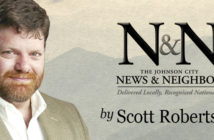By Jeff Keeling
A recent run through the woods behind ETSU with the lithe and gazelle-like Angela got me thinking. When selecting which of our metro area’s assets to invest in, and how much to invest in each, our local leaders would do well to expose some of our diamonds in the rough in addition to plucking low-hanging fruit.
As we ran down a forested path, the towering oak, beech and maple above us creating a shaded haven a good 10 degrees cooler than the sweltering sidewalks, a mountain biker pedaled toward us. We stopped briefly, and I noticed his shirt: “Brody College of Medicine,” it read. My standard interrogation ensued, and we learned the young man was here doing his residency after graduating from Brody, which is part of East Carolina University.
The cyclist had already discovered the University Woods – something that makes Johnson City unique and attractive to longtime residents and young professionals alike. The woods are one of many low-profile attributes on which our community can build its reputation as a great place to live. While the woods don’t need much financial investment to shine (if any), a number of other gems have the potential to shine even brighter – to our community’s long-term benefit, I believe – with relatively small investments.
The development of a bike park on Tannery Knob is a good example. Further development of Jacob’s Nature Park at Sinking Creek would represent another. Growth in programming and more marketing for ETSU’s bluegrass program, its fossil site in Gray and its Center for Excellence in Sport Science and Coach Education all could yield major dividends in raising the area’s national and international profile and ensuring more locals are aware of and benefit from these great assets.
Many other assets unique to this area, if adequately developed and promoted, could help convince people like that medical resident we encountered to make this jewel of the Southern Appalachians their long-term home. The people we need to keep our area growing – both in population and economic strength – tend to seek experiences and authenticity.
It is easy for leaders to find apparent solutions in the obvious. In ETSU’s case, the return of football is a good example. As for the city, new bricks and mortar retail opportunities could qualify; so could large-scale investments in athletic fields. Outside the city, expensive improvements to Knob Creek Road in anticipation of future growth north of town fits the description.
Each of these examples represents an accepted standard. Nothing about having a college football program says “Johnson City, Tennessee” in some unique way. Many small metro areas want more shopping centers. “Build it and they will come” is a common refrain surrounding planned road infrastructure and athletic amenities. If this were not so, would we have found consultants to come in and provide us with studies telling us how great it will be if we build this or that?
Another thing each of these examples represents is a massive expenditure (eight figures each) of public and private funds. In each case, we’re told of a return on investment that will make it all worthwhile. The ability to attract more students and grow the university, in the case of football; the influx of visiting athletes and their families making our cash registers ring and filling our hotel beds, in the case of new fields; and the long-term residential and commercial growth of an urban corridor similar to North State of Franklin Road, in the case of Knob Creek improvements.
None of these arguments is necessarily insupportable. Nor, in my opinion, is any of them ironclad just because some consultants have essentially told the funders of their research what those funders want to hear.
I am not making a judgment on whether our leaders should or should not pull the trigger on the large projects cited above. Regardless of those decisions, though, if we neglect to search out and polish up our diamonds in the rough – usually for a fraction of what it costs to complete the big-ticket, consultant-studied projects – we’ll be bypassing countless low-cost, high-yield opportunities to enhance our community’s future desirability.




